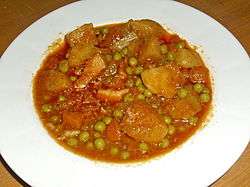List of Italian soups
This is a list of Italian soups. Soups are sometimes served as the primo, or first course in Italian cuisine. In some regions of Italy, such as Veneto, soup is eaten more than pasta.[1]
Italian soups
This is a dynamic list and may never be able to satisfy particular standards for completeness. You can help by expanding it with reliably sourced entries.
- Acquacotta – originally a peasant food, its preparation and consumption dates back to ancient history[2]
- Bagnun – based mainly on anchovies
- Bean soup – the Veneto region of Italy is well known for its bean soups[3]
- Buridda – a seafood soup or stew from Liguria in Northern Italy[4]
- Garmugia – originated in Lucca, Tuscany, central Italy[5][6]
- Ginestrata – originated in Tuscany, Northern Italy, and can be described as a thin, lightly spiced egg-based soup[7][8][9]
- Macaroni soup – a traditional dish in Italy that is sometimes served with beans, which is known as pasta e fagioli[10]
- Maccu – a Sicilian soup and also a foodstuff that is prepared with dried and crushed fava beans (also known as broad beans) and fennel as primary ingredients.[11][12] It dates back to ancient history.[11][13][14]
- Minestra di ceci – prepared with chickpeas as a main ingredient, it is a common soup in the Abruzzo region of Italy.[15][16]
- Minestrone – a thick soup of Italian origin made with vegetables, often with the addition of pasta or rice. Common ingredients include beans, onions, celery, carrots, stock, and tomatoes.
- Panada – In northeastern Italy, it serves as an inexpensive meal in the poor areas of the countryside. It may be enriched with eggs, beef broth, and grated cheese. It was frequently prepared as a meal for elderly or ill people.
- Pappa al pomodoro – a thick Tuscan soup typically prepared with fresh tomatoes, bread, olive oil, garlic, basil, and various other fresh ingredients
- Passatelli in Brodo – originating from the Emilia-Romagna region of Italy, this soup is prepared using Parmesan cheese, bread crumbs and nutmeg.[17]
- Ribollita – a famous Tuscan soup, a hearty potage made with bread and vegetables.[18] There are many variations but the main ingredients always include leftover bread, cannellini beans and inexpensive vegetables such as carrot, cabbage, beans, silverbeet, cavolo nero, and onion. Its name literally means "reboiled".
- Sciusceddu – prepared using meatballs and eggs as primary ingredients
- Soup all'Imperatrice – made from breast of fowl, eggs, ground rice, clear stock, salt, pepper and nutmeg[19]
- Soup alla Canavese – made from white stock, tomato puree, butter, carrot, celery, onion, cauliflower, bacon fat, Parmesan cheese, parsley, sage, salt and pepper[20]
- Stracciatella – consists of meat broth and small shreds of an egg-based mixture, prepared by drizzling the mixture into boiling broth and stirring
- Soup alla modenese – made with stock, spinach, butter, salt, eggs, Parmesan cheese, nutmeg and croutons[21]
- Zuppa toscana – made with Italian sausage, crushed red peppers, diced white onion, bacon, garlic puree, chicken bouillon, heavy cream, and potatoes
See also
References
- ↑ Caggiano, B. (2002). Biba's Northern Italian Cooking. Penguin Publishing Group. pp. 20–21. ISBN 978-1-4406-2391-2.
- ↑ Romer, Elizabeth (1989). The Tuscan Year: Life and Food in an Italian Valley. Macmillan. pp. 103–106. ISBN 0865473870.
- ↑ Caggiano, B. (2002). Biba's Northern Italian Cooking. Penguin Publishing Group. p. 33. ISBN 978-1-4406-2391-2.
- ↑ Perfect Order. p. 74.
- ↑ Cucina Povera: Tuscan Peasant Cooking. p. 63.
- ↑ A Culinary Traveller in Tuscany. pp. 77–78.
- ↑ Solley, Patricia (2010). An Exaltation of Soups. Crown Publishing Group. pp. 65–66. ISBN 0307523136.
- ↑ Capatti, Alberto; Montanari, Massimo (2013). Italian Cuisine: A Cultural History. Columbia University Press. p. 15. ISBN 0231509049.
- ↑ Sinclair, Charles (2009). Dictionary of Food:. A & C Black. ISBN 1408102188. Retrieved 12 September 2014.
- ↑ "Cara Mia Due". Newsday. Retrieved 2008-08-06.
- 1 2 Helstosky, Carol (2009). Food Culture in the Mediterranean. Greenwood Publishing Group. p. 7. ISBN 0313346267.
- ↑ Facaros, Dana; Pauls, Michael (2008). Sicily. New Holland Publishers. p. 53. ISBN 1860113974.
- ↑ La Place, Viana; Kleiman, Evan (2011). Cucina Rustica. Harper Collins. pp. 44–45. ISBN 0060935111.
- ↑ Simeti, Mary Taylor (1989). Pomp and sustenance: twenty-five centuries of Sicilian food. Knopf. pp. 9–10.
- ↑ De Vita, O.Z.; Fant, M.B.; Marini, L.; Hyers, Gentl & (2013). Sauces & Shapes: Pasta the Italian Way. W. W. Norton. p. 248. ISBN 978-0-393-08243-2.
- ↑ Talbott, M.; Schlechter, A.; Project, Rome Sustainable Food (2012). Zuppe:. Rome sustainable food project. Little Bookroom. p. 95. ISBN 978-1-892145-97-0.
- ↑ Caggiano, B. (2002). Biba's Northern Italian Cooking. Penguin Publishing Group. p. 27. ISBN 978-1-4406-2391-2.
- ↑ Zeldes, Leah A. (2010-12-08). "Eat this! Ribollita, ribsticking winter 'soup' from Tuscany". Dining Chicago. Chicago's Restaurant & Entertainment Guide, Inc. Retrieved 2011-05-18.
- ↑ The Cooks 200 Genuine Italian Recipes - Paul Cresswell. p. 19.
- ↑ Mrs. W. G. Waters (1901). The Cook's Decameron: A Study in Taste, Containing Over Two Hundred Recipes for Italian Dishes. London: W. Heinemann. p. 106. Retrieved 31 May 2013.
- ↑ Almanacco italiano (in Italian). H. Bemporad & figlio. 1902. p. 362.
External links
| Wikimedia Commons has media related to Soups and stews of Italy. |
This article is issued from Wikipedia - version of the 11/22/2016. The text is available under the Creative Commons Attribution/Share Alike but additional terms may apply for the media files.
.jpg)

.jpg)
